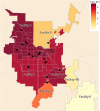Community-Scale Wastewater Surveillance of Candida auris during an Ongoing Outbreak in Southern Nevada
- PMID: 36656763
- PMCID: PMC9893721
- DOI: 10.1021/acs.est.2c07763
Community-Scale Wastewater Surveillance of Candida auris during an Ongoing Outbreak in Southern Nevada
Abstract
Candida auris is an opportunistic fungal pathogen and an emerging global public health threat, given its high mortality among infected individuals, antifungal resistance, and persistence in healthcare environments. This study explored the applicability of wastewater surveillance for C. auris in a metropolitan area with reported outbreaks across multiple healthcare facilities. Influent or primary effluent samples were collected over 10 weeks from seven sewersheds in Southern Nevada. Pelleted solids were analyzed using an adapted quantitative polymerase chain reaction (qPCR) assay targeting the ITS2 region of the C. auris genome. Positive detection was observed in 72 of 91 samples (79%), with higher detection frequencies in sewersheds serving healthcare facilities involved in the outbreak (94 vs 20% sample positivity). Influent wastewater concentrations ranged from 2.8 to 5.7 log10 gene copies per liter (gc/L), and primary clarification achieved an average log reduction value (LRV) of 1.24 ± 0.34. Presumptive negative surface water and wastewater controls were non-detect. These results demonstrate that wastewater surveillance may assist in tracking the spread of C. auris and serve as an early warning tool for public health action. These findings provide the foundation for future application of wastewater-based epidemiology (WBE) to community- or facility-level surveillance of C. auris and other high consequence, healthcare-associated infectious agents.
Keywords: Candida auris; antifungal resistance; healthcare-associated infections (HAIs); public health surveillance; wastewater-based epidemiology (WBE).
Conflict of interest statement
The authors declare no competing financial interest.
Figures


References
-
- Pacilli M.; Kerins J. L.; Clegg W. J.; Walblay K. A.; Adil H.; Kemble S. K.; Xydis S.; McPherson T. D.; Lin M. Y.; Hayden M. K.; Froilan M. C.; Soda E.; Tang A. S.; Valley A.; Forsberg K.; Gable P.; Moulton-Meissner H.; Sexton D. J.; Jacobs Slifka K. M.; Vallabhaneni S.; Walters M. S.; Black S. R. Regional Emergence of Candida auris in Chicago and Lessons Learned From Intensive Follow-up at 1 Ventilator-Capable Skilled Nursing Facility. Clin. Infect. Dis. 2020, 71, e718–e725. 10.1093/cid/ciaa435. - DOI - PMC - PubMed
-
- Centers for Disease Control and Prevention. Antibiotic Resistance Threats in the United States, 2019. https://www.cdc.gov/drugresistance/biggest-threats.html.
-
- World Health Organization. First meeting of the WHO antifungal expert group on identifying priority fungal pathogens: meeting report; Geneva, Switzerland, 2020; pp 1–13.
Publication types
MeSH terms
Substances
Grants and funding
LinkOut - more resources
Full Text Sources
Medical
Miscellaneous

